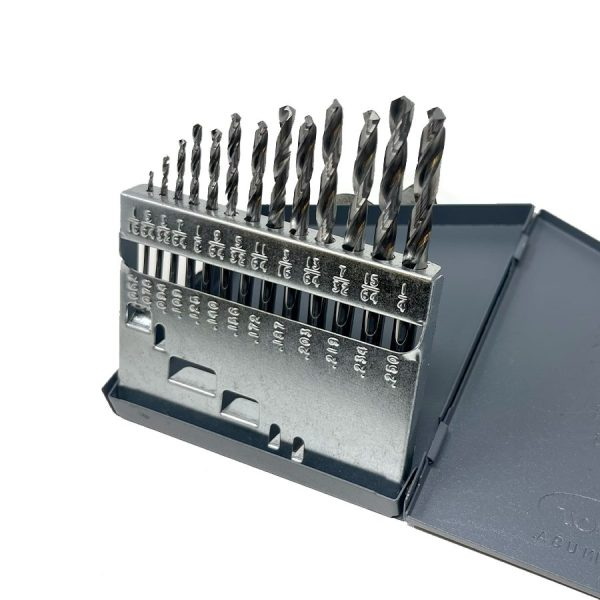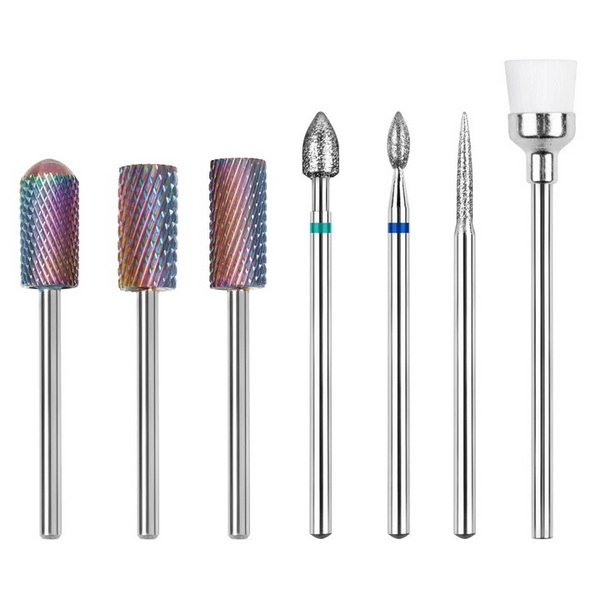Content Menu
● Introduction
● What Are Carbide Bits?
● What Are Tungsten Bits?
● Material Science: Carbide vs. Tungsten
>> What Is Tungsten Carbide?
>> Tungsten Steel vs. Solid Carbide
● Comparative Strength and Hardness
● Durability and Wear Resistance
● Applications and Best Use Cases
>> Carbide Bits
>> Tungsten Steel Bits
● Cost and Value Considerations
● Safety and Handling
● Environmental Impact and Sustainability
● Innovations and Trends in Drill Bit Technology
● Conclusion
● FAQ: Carbide vs. Tungsten Bits
>> 1. What is the main difference between carbide bits and tungsten bits?
>> 2. Are carbide bits always better than tungsten bits?
>> 3. Can carbide bits drill through stainless steel and hardened materials?
>> 4. Why are carbide bits more expensive?
>> 5. How can I tell if a drill bit is carbide or tungsten steel?
● Citations:
When it comes to cutting, drilling, or shaping some of the world's hardest materials, the debate between carbide bits and tungsten bits is both common and critical. Whether you're a professional machinist, a construction worker, or a DIY enthusiast, choosing the right bit can make all the difference in efficiency, precision, and cost-effectiveness. This comprehensive guide will explore the science, applications, strengths, and limitations of both carbide and tungsten bits. We'll also provide visual references, practical tips, and a detailed FAQ to help you make the best decision for your projects.

Introduction
The right drill or cutting bit is the cornerstone of efficient, precise, and safe work—especially when dealing with tough materials like hardened steel, masonry, or ceramics. Two of the most popular options are carbide bits and tungsten bits, but which is truly stronger? This article will clarify the terminology, break down the science, and offer practical guidance for both professionals and hobbyists.
What Are Carbide Bits?
Carbide bits are cutting or drilling tools primarily made from tungsten carbide, a compound of tungsten and carbon. These bits are available as solid carbide or carbide-tipped, where a steel body is tipped with tungsten carbide to enhance cutting performance.
Key Features:
- Made from tungsten carbide, among the hardest known materials.
- Extremely hard and wear-resistant.
- Retain sharpness and cutting ability at high temperatures.
- Used for drilling, milling, and cutting hard materials like concrete, masonry, ceramics, and hardened steel.
Carbide bits are especially valued in industries where tool longevity and precision are paramount. Their ability to maintain a sharp edge even under extreme heat and pressure makes them indispensable for high-speed machining and industrial-scale operations.
What Are Tungsten Bits?
The term "tungsten bits" can be confusing, as it is often used interchangeably with "tungsten carbide bits." However, in technical terms, pure tungsten is rarely used for drill bits or cutting tools due to its brittleness. Instead, the industry standard is tungsten carbide—a composite material that combines tungsten's strength with carbide's hardness.
Key Features:
- Usually refers to tungsten carbide, not pure tungsten.
- Sometimes called "tungsten steel" in certain regions, which is a form of high-speed steel alloyed with tungsten.
- Used in applications requiring exceptional hardness and durability.
Tungsten steel bits, while harder than standard steel bits, do not match the hardness or wear resistance of carbide bits. They are, however, less brittle and often more affordable, making them suitable for general-purpose drilling and cutting.
Material Science: Carbide vs. Tungsten
What Is Tungsten Carbide?
Tungsten carbide is a chemical compound composed of equal parts tungsten and carbon atoms. It is produced through powder metallurgy, where tungsten carbide powder is combined with a binder (usually cobalt) and then sintered at high temperatures to form a dense, hard material.
Properties of Tungsten Carbide:
- Mohs hardness: 9–9.5 (just below diamond)
- Extremely high density and compressive strength
- Superior wear and heat resistance
Tungsten Steel vs. Solid Carbide
- Tungsten Steel: An alloy of steel with 15–25% tungsten, sometimes called "high-speed steel" or "tool steel." It is harder than standard steel but softer than tungsten carbide.
- Solid Carbide: Contains >80% tungsten carbide, sintered with a binder. Hardness typically exceeds HRC 65, making it suitable for the toughest applications.
Comparative Strength and Hardness
| Property | Carbide Bits (Tungsten Carbide) | Tungsten Steel Bits |
| Hardness (Mohs) | 9–9.5 | 8–8.5 |
| Hardness (HRC) | 85–92 | 65–70 |
| Wear Resistance | Excellent | Good |
| Heat Resistance | Excellent | Moderate |
| Brittleness | High | Moderate |
| Cost | High | Moderate |
Summary:
Carbide bits (tungsten carbide) are significantly harder and more wear-resistant than tungsten steel bits. However, they are also more brittle and expensive.
Durability and Wear Resistance
Carbide bits are renowned for their longevity. They can maintain their edge up to ten times longer than high-speed steel or tungsten steel bits. Their resistance to high temperatures makes them ideal for high-speed and heavy-duty applications, such as CNC machining, where tool life directly impacts productivity and cost.
Tungsten steel bits, while durable, will dull faster and are more prone to deformation under extreme stress. They are suitable for softer materials and less demanding jobs where frequent bit replacement is acceptable.
Applications and Best Use Cases
Carbide Bits
- Industrial drilling: Masonry, concrete, ceramics, glass, hardened steel.
- Precision machining: Aerospace, automotive, medical device manufacturing.
- Heavy-duty cutting: Milling, turning, and routing of hard metals and composites.
- PCB manufacturing: Micro-drilling for electronics.
Tungsten Steel Bits
- General-purpose drilling: Softer metals, wood, plastics.
- Cost-sensitive jobs: Where tool life is less critical and replacement is affordable.
- DIY projects: Home repairs, hobbyist woodworking, and light metalwork.

Cost and Value Considerations
| Bit Type | Typical Price Range (USD) | Replacement Frequency | Best For |
| Carbide | $15–50 per bit | Low | Professionals, production shops |
| Tungsten Steel | $5–20 per bit | Moderate | DIY, general maintenance |
Carbide bits are more expensive upfront but last much longer, especially in demanding environments. For occasional or light-duty use, tungsten steel bits may be more cost-effective.
Safety and Handling
- Carbide bits are brittle and can chip or break if mishandled or dropped. Use steady, even pressure and avoid lateral forces.
- Tungsten steel bits are less brittle but can deform under excessive heat or pressure.
Pro Tip: Always use proper feeds and speeds, lubricate when necessary, and wear appropriate personal protective equipment.
Environmental Impact and Sustainability
With increasing attention to environmental impact, the choice of tool material is not just about performance and cost. Both tungsten and carbide mining and processing have environmental consequences:
- Tungsten mining can lead to habitat destruction and water pollution if not managed responsibly.
- Carbide production involves energy-intensive sintering processes and the use of cobalt, which is often sourced from regions with environmental and ethical concerns.
Recycling:
Both tungsten and carbide bits can be recycled. Many manufacturers offer buy-back or recycling programs for used carbide tools, reducing environmental impact and conserving resources.
Innovations and Trends in Drill Bit Technology
The field of cutting and drilling tools is constantly evolving. Recent innovations include:
- Nano-coatings: Advanced coatings like titanium nitride (TiN) or diamond-like carbon (DLC) further enhance the wear resistance and longevity of carbide bits.
- Hybrid materials: Some modern bits combine carbide tips with flexible steel shanks, balancing hardness with shock absorption.
- 3D printing: Additive manufacturing is being explored for creating complex, high-performance tool geometries that were previously impossible.
These advancements continue to push the boundaries of what carbide and tungsten-based bits can achieve, making them even more effective and versatile.
Conclusion
Carbide bits, specifically those made from tungsten carbide, are unequivocally stronger, harder, and more wear-resistant than bits made from tungsten steel or other tungsten alloys. This makes them the preferred choice for industrial, heavy-duty, and precision applications where tool longevity and performance are paramount. However, their brittleness and higher cost mean they are best reserved for situations where their superior properties will be fully utilized.
For general-purpose drilling or less demanding jobs, tungsten steel (often called "tungsten bits") offers a good balance of performance and cost. Understanding the distinctions between these materials ensures you select the right tool for your project, maximizing efficiency, accuracy, and value.

FAQ: Carbide vs. Tungsten Bits
1. What is the main difference between carbide bits and tungsten bits?
Carbide bits are made from tungsten carbide, a compound of tungsten and carbon, and are much harder and more wear-resistant than tungsten steel bits, which are steel alloys with added tungsten.
2. Are carbide bits always better than tungsten bits?
Carbide bits outperform tungsten steel bits in hardness and durability, but they are also more brittle and expensive. For heavy-duty or precision work, carbide is superior. For general use, tungsten steel may suffice.
3. Can carbide bits drill through stainless steel and hardened materials?
Yes, carbide bits are specifically designed to cut through the hardest materials, including stainless steel, hardened steel, ceramics, and masonry.
4. Why are carbide bits more expensive?
Carbide bits are made from complex, expensive materials and manufacturing processes. Their longevity and performance in demanding applications justify the higher cost for professionals and industrial users.
5. How can I tell if a drill bit is carbide or tungsten steel?
Carbide bits usually have a grayish-white color, are heavier, and maintain a sharp edge longer. Tungsten steel bits look more like standard steel and are lighter. Carbide bits are also more brittle and should be handled carefully.
Citations:
[1] https://benchmarkabrasives.com/blogs/news/hss-vs-cobalt-vs-carbide-drill-bits-what-to-choose
[2] https://www.cncsparetools.com/new/Difference-between-solid-carbide-and-Tungsten-steel.html
[3] https://hncarbide.eu/choosing-the-right-drill-bit-hss-vs-carbide-vs-cobalt/
[4] https://www.istockphoto.com/photos/tungsten-carbide-drill-bits
[5] https://www.speedtigertools.com/solution/ins.php?index_id=102
[6] https://shop.machinemfg.com/comprehensive-guide-to-drill-bits-and-their-applications/
[7] https://www.thdrillingtools.com/blog/carbide-drill-bits-vs-titanium-3-key-differences
[8] https://ruwag.co.za/blogs/news/everything-you-need-to-know-about-carbide-drill-bits
[9] https://www.richconn-cnc.com/metal-drill-bits-guide.html
[10] https://guesstools.com/how-to-tell-if-a-drill-bit-is-carbide/
[11] https://heegermaterials.com/blog/79_tungsten-carbide-vs-titanium-carbide.html
[12] https://www.tivoly.com/en/choose-hss-drill-carbide-drill
[13] https://www.coweecarbide.com/tungsten-carbide-vs-carbide-drill-bits/
[14] https://www.kennametal.com/us/en/resources/blog/metal-cutting/tungsten-carbide-versus-cobalt-drill-bits.html
[15] https://qlt.tools/blogs/insights/strong-drill-bits
[16] https://360civil-engineering.com/are-carbide-or-tungsten-bits-better-for-concrete-a-complete-guide/
[17] https://www.istockphoto.com/photos/carbide-bit
[18] https://www.shutterstock.com/search/solid-carbide-drill
[19] https://www.freepik.com/free-photos-vectors/carbide-drill
[20] https://www.shutterstock.com/search/carbon-drill-bit
[21] https://stock.adobe.com/search?k=tungsten+carbide
[22] https://www.shutterstock.com/search/tungsten-drill-bits
[23] https://www.drillbitwarehouse.com/product-category/carbide-drill-bits/
[24] https://www.shutterstock.com/search/tungsten-drill
[25] https://www.alamy.com/stock-photo/carbide-drill-and-cnc.html
[26] https://www.istockphoto.com/photos/tungsten-carbide-drill-bits?page=3
[27] https://www.coweecarbide.com/tungsten-carbide-vs-diamond-drill-bits-2/
[28] https://www.freepik.com/free-photos-vectors/carbide-drill-bit
[29] https://benchmarkabrasives.com/blogs/news/hss-vs-cobalt-vs-carbide-drill-bits-what-to-choose
[30] https://ctpcryogenics.com/carbide-drill-bits/
[31] https://industrialmetalservice.com/metal-university/differentiating-tungsten-carbide-vs-steel-and-other-tooling/
[32] https://www.screwfix.com/guides/tools/guide-to-types-of-drill-bits
[33] https://samhotool.com/blog/carbide-drill-bit/
[34] https://www.coweecarbide.com/tungsten-carbide-drill-bits-vs-cobalt-2/
[35] https://www.kennametal.com/us/en/resources/blog/metal-cutting/how-to-choose-the-right-carbide-drill-bit.html
[36] https://www.retopz.com/57-frequently-asked-questions-faqs-about-tungsten-carbide/
[37] https://www.linkedin.com/pulse/drill-bits-carbide-toolings-miya-wang
[38] https://gtse.co.uk/blog/the-ultimate-guide-to-drill-bits-2021
[39] https://in.misumi-ec.com/vona2/fs_machining/T0107000000/?CategorySpec=00000018230%3A%3Ad
[40] https://www.alamy.com/stock-photo/drill-bit.html
[41] https://www.thdrillingtools.com/blog/carbide-drill-bits-vs-titanium-3-key-differences
[42] https://www.gettyimages.hk/detail/%E7%85%A7%E7%89%87/tungsten-carbide-machining-drill-bits-%E5%85%8D%E7%89%88%E7%A8%85%E5%9C%96%E7%89%87/1297149846?phrase=food
[43] https://guesstools.com/how-to-tell-if-a-drill-bit-is-carbide/
[44] https://clebitco.com/bits-n-tips/carbide-vs-hss-bits-a-detailed-guide-maximizing-your-cnc-work/
















